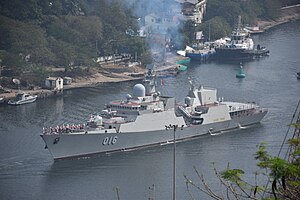 Quang Trung - one of the two ships in the second batch of Gepard 3.9 built for the Vietnam People's Navy
| |
| Class overview | |
|---|---|
| Name | Gepard class (Project 1166.1) |
| Builders | Zelenodolsk Plant Gorky |
| Operators | |
| Preceded by | |
| Subclasses |
|
| Cost | |
| Built | 1991–2016 |
| Planned | 10 |
| Completed | 6 |
| Active | 6 |
| General characteristics | |
| Type | Frigate |
| Displacement |
|
| Length | Approx 102.4 m (336 ft) (Gepard 3.9 batch II) |
| Beam |
|
| Draught | 5.7 m (19 ft) |
| Propulsion | Twin-shaft CODOG, FPP, 2 x 14,300 + 1 x 6,000 (kW) |
| Speed | 29 knots (54 km/h; 33 mph) |
| Range | 4,000 nmi (7,000 km) at 10 knots (19 km/h) |
| Endurance | 20 days |
| Complement | 94 |
| Sensors and processing systems |
|
| Electronic warfare & decoys |
|
| Armament |
|
| Notes | [1] |
The Gepard-class frigates, Russian designation Project 11661, is a Russian class of frigates that were intended as successors to the earlier Koni-class frigates and Grisha, and Parchim-class corvettes. The first unit of the class, Yastreb (Hawk), was laid down at the Zelenodol'sk Zavod shipyard at Tatarstan in 1991. She was launched in July 1993, after which she began fitting out; fitting was nearly completed by late 1995, when it was suspended due to lack of funds. Renamed Tatarstan, the ship was finally completed in July 2002, and became the flagship of the Caspian Flotilla. She has two sister ships, Albatross (renamed Dagestan), and Burevestnik (Storm Petrel), which was still under construction as of 2012[update].
Vietnam is the main operator of the class with its navy having commissioned 4 frigates - twice the size of Russia's Project 11661 inventory - and having plans to order at least 2 more.